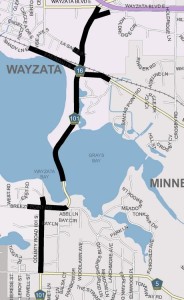
The Bushaway Road/County Road 101 project along Lake Minnetonka is underway. Construction started last fall and will run until fall of 2016. The 3 mile stretch serves 11,000 vehicles per day with anticipated traffic by 2032 ranging from 14,000-15,600 vehicles per day. While the project includes adding turn lanes, replacing deteriorating pavement structure, sewer work, and reconstructing an old railway bridge, it isn’t adding any driving lanes. The project instead adds an 8 foot multi-use bike and walking trail on the east side of the scenic roadway.
The Bushaway road bike lane has been under consideration since 1997 as a part of the Hennepin County Bicycle Transportation Plan and The Met Council found “the existing corridor is unsafe for bicyclists and pedestrians, given the existing narrow roadway and shoulder widths” as a part of their 2014 Twin Cities Regional Bicycle System Study, under the Council’s “Thrive MSP 2040” proposal. The Thrive MSP plan includes 1,270 miles of proposed “network corridors” and 579 of those miles are “Priority regional bicycle transportation corridors.”
As Alpha News reported in June on the $3 million Luce line bike and pedestrian bridge story, The Met Council and Three Rivers Park District recently outlined aggressive goals in the “Hennepin County 2040 Bicycle Transportation Plan” to complete an average of 20 new miles of bike paths every year and have a bikeway within 1/2 mile of 90% of homes in Hennepin County. The plan also calls for reducing per capita vehicle miles of travel 20% from 2000 levels by 2040 and for reducing the “gender gap” for bicycle commuters.
The Bushaway road project costs went from an estimated $19 million in 2009 to $30 million when railway bridge and sewer work were added to the scope. It went up to $41 million by early last year “because of more detailed plans” including “landscaping and architectural details.” Finally the budget ballooned to $56 million last fall due to high water levels on Lake Minnetonka, an increase to materials cost, and construction limits along the corridor. The budget includes $3 million in consulting fees alone and includes $250,000 for Hamline University to do recovery work at a Native American burial site discovered on the job site.
Per the Hennepin County 2040 Plan, “On-street bikeways can range from extremely lowcost treatments, such as bicycle boulevards that may cost $10,000-$15,000 per mile, to protected bikeways like cycle tracks that can cost up to $200,000 per mile and even higher when curb and raised median construction is involved. For off-street bikeways, multi-use trails can cost an estimated $500,000 per mile to around $700,000 per mile for more complex trail construction. For comparison, the estimated average cost for a road is $1.8 million per lane mile and $85 million-$90 million per mile for light rail transit.”
This 8-foot multi-use trail along the metro’s poshest lake will be paid for by state and county taxpayers who will cover approximately 67% of the project’s cost. The Metropolitan Council, also funded by state taxpayers, and local municipalities will pick up the rest of the tab.





